Abstract
Lightcurves for 35 near-Earth asteroids (NEAs) were obtained at the Center for Solar System Studies-Palmer Divide Station (CS3-PDS) from 2014 December through 2015 March. One object, (159454) 2000 DJ8, may be a highly bifurcated body, or a close binary.
CCD photometric observations of 35 near-Earth asteroids (NEAs) were made at the Center for Solar System Studies-Palmer Divide Station (CS3-PDS) from 2015 January – March. Table I lists the telescope/CCD camera combinations used for the observations. All the cameras use CCD chips from the KAF blue-enhanced family and so have essentially the same response. The pixel scales for the combinations range from 1.24-1.60 arcsec/pixel.
Table I.
List of CS3-PDS telescope/CCD camera combinations.
| Desig | Telescope | Camera | |
|---|---|---|---|
| Squirt | 0.30–m f/6.3 | Schmidt–Cass | ML–1001E |
| Borealis | 0.35–m f/9.1 | Schmidt–Cass | FLI–1001E |
| Eclipticalis | 0.35–m f/9.1 | Schmidt–Cass | STL–1001E |
| Australius | 0.35–m f/9.1 | Schmidt–Cass | STL–1001E |
| Zephyr | 0.50–m f/8.1 | R–C | FLI–1001E |
All lightcurve observations were unfiltered since a clear filter can result in a 0.1-0.3 magnitude loss. The exposure duration varied depending on the asteroid’s brightness and sky motion. Guiding on a field star sometimes resulted in a trailed image for the asteroid.
Measurements were done using MPO Canopus. If necessary, an elliptical aperture with the long axis parallel to the asteroid’s path was used. The Comp Star Selector utility in MPO Canopus found up to five comparison stars of near solar-color for differential photometry. Catalog magnitudes were usually taken from the MPOSC3 catalog, which is based on the 2MASS catalog (http://www.ipac.caltech.edu/2mass) but with magnitudes converted from J-K to BVRI using formulae developed by Warner (2007). When possible, magnitudes are taken from the APASS catalog (Henden et al., 2009) since these are derived directly from reductions based on Landolt standard fields. Using either catalog, the nightly zero points have been found to be consistent to about ± 0.05 mag or better, but on occasion are as large as 0.1 mag. This consistency is critical to analysis of long period and/or tumbling asteroids. Period analysis is also done using MPO Canopus, which implements the FALC algorithm developed by Harris (Harris et al., 1989).
In the plots below, the “Reduced Magnitude” is Johnson V as indicated in the Y-axis title. These are values that have been converted from sky magnitudes to unity distance by applying −5*log (rΔ) to the measured sky magnitudes with r and Δ being, respectively, the Sun-asteroid and Earth-asteroid distances in AU. The magnitudes were normalized to the given phase angle, e.g., alpha(6.5°), using G = 0.15, unless otherwise stated. The X-axis is the rotational phase, ranging from −0.05 to 1.05.
For the sake of brevity, only some of the previously reported results may be referenced in the discussions on specific asteroids. For a more complete listing, the reader is directed to the asteroid lightcurve database (LCDB; Warner et al., 2009). The on-line version at http://www.minorplanet.info/lightcurvedatabase.html allows direct queries that can be filtered a number of ways and the results saved to a text file. A set of text files of the main LCDB tables, including the references with bibcodes, is also available for download. Readers are strongly encouraged to obtain, when possible, the original references listed in the LCDB for their work.
1627 Ivar.
There are numerous entries in the LCDB for this near-Earth asteroid, all close to 4.8 hours, including Warner (2014a) who found P = 4.8003 h, A = 0.28 mag in early 2015 June and then P = 4.7961 h, A = 0.73 mag in mid-August. A shape model (Kaasalainen et al., 2004) already exists. The main benefit of additional lightcurves now is to improve on the model and see if the YORP (Yakovsky-O’Keefe-Radzievskii-Paddack) effect is slowly changing the sidereal period of the asteroid, as seen in other asteroids, e.g., 1862 Apollo (Kaasalainen et al., 2007).

1864 Daedalus.
The period for this NEA was first determined more than 50 years ago (Gehrels et al., 1971; 8.57 h). Subsequent results include Pravec et al. (1995, 8.572 h). Thomas et al. (2014) determined that Daedalus is taxonomic type Sq on the SMASS system (Small Main-Belt Asteroid Spectroscopic Survey; see Bus et al., 2002a/b). The period of 8.575 h derived from the 2015 CS3-PDS observations is in good agreement with the earlier results.

4401 Aditi.
The observations in 2015 March at CS3-PDS were follow-up to those made in 2014 August-September.

The amplitude at the earlier observations was A = 0.64 mag (α = 33°) and only A = 0.29 mag for the latter despite a similar phase angle of α = 35°. In this case, there was a significant difference in the viewing aspect as judged by the phase angle bisector longitude and latitude (LPAB and BPAB; see Harris et al., 1984). For comparison the PAB values were: 2014 (23°, −11°) and 2015 (156°, 36°). The significant difference in amplitude and lightcurve shapes between the two data sets will be helpful when trying to model the asteroid when even more data are available.
(5131) 1990 BG.
No previous results were found in the LCDB for 1990 BG. The period given is the best bimodal solution in a search from 10 to 60 hours in that the slopes of the individual nights follow the Fourier model curve. A solution at about 18.5 hours produced an unlikely monomodal solution and its double period of about 37 hours an even more unlikely solution based on a highly asymmetric lightcurve with large gaps.
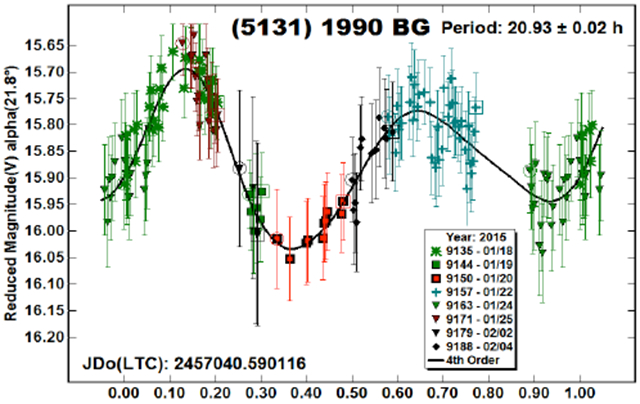
11066 Sigurd.
Pravec et al. (1998) reported a period of 8.4958 h and Krugly et al. (2002) found a period of 8.496 h. The result here is in good agreement with those results. In addition, the 2015 lightcurve shows the lowest amplitude of the three, the greater difference being 0.18 mag when comparing 2015 to 2002.

(22099) 2000 EX106.
The period found from the 2015 CS3-PDS observations is in good agreement with the one of 6.334 h found by Pravec et al. (2002).

(22771) 1999 CU3.
Based on observations in 2003 September-November, Pravec et al. (2003) found an average synodic period of 3.7822 h. The amplitude varied from 0.81-1.25 mag. The period of 3.780 h reported here is in good agreement. The lower amplitude of 0.12 mag suggests a nearly pole-on viewing aspect. If so, then the spin axis ecliptic longitude would be near the phase angle bisector longitude (LPAB) of 175° (or 355°).

(39796) 1997 TD.
Given that the slopes of individual sessions do not follow the slope of the Fourier model curve and the expected damping time for tumbling exceeds the age of the Solar System (see Pravec et al., 2005; 2014), it’s likely that this slow rotator is a tumbler, i.e., in non-principal axis rotation (NPAR).

(85990) 1999 JV6.
Warner (2014b) found P = 6.538 h, A = 0.87 mag (α = 12°) based on observations in 2014 January. The 2015 January observations, A = 0.93 mag (α = 26°), were at almost the same phase angle bisector longitude and latitude. The difference in amplitude is probably due to the difference in phase angles.

(86067) 1999 RM28.
The LCDB did not have any lightcurve entries for 1999 RM28. However, it did note that Thomas et al. (2014) determined that this is a type Q object, which is an intermediate class between the S and V types. The period spectrum for 1999 RM28 is highly ambiguous. After reviewing half-period, double period, and double period split halves solutions, a period of 9.196 h is adopted for this paper. See Harris et al. (2014) for a discussion of a split halves plot and its value for eliminating ambiguous periods.
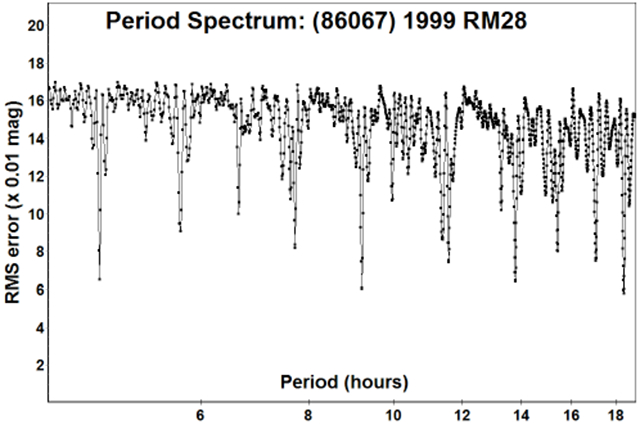

(90416) 2003 YK118.
The period spectrum for 2003 YK118 shows two likely periods. Even though the amplitude is only 0.13 mag and, therefore, a bimodal solution cannot be assumed (Harris et al., 2014), the longer period of 43.58 h with a bimodal lightcurve is adopted for this paper. This is based mostly on the slightly better fit to the Fourier model curve. There were no previous entries in the LCDB for this NEA.
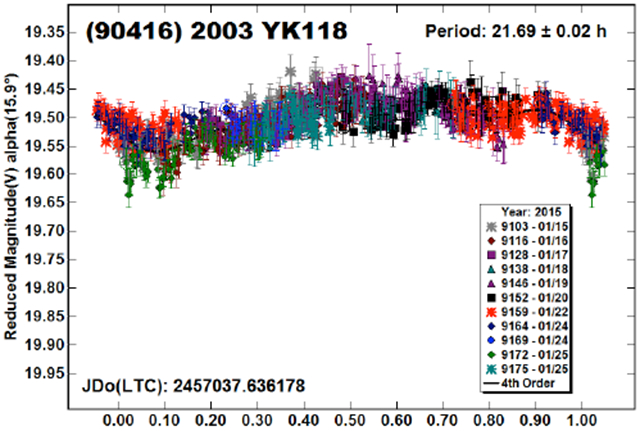

(99248) 2001 KY66.
This asteroid faded from V = 18.2 to 18.6 over the course of the observations. The only telescope available was the smallest one at CS3, the 0.30-m SCT, which resulted in a noisier than preferred data set. The period spectrum shows a strong solution at 19.7 hours. However, the lightcurve for that period is far from convincing due to the irregular shape. The period reported here should not be considered definitive. In 2019, 2001 KY66 returns, reaching V ~ 15.5 at +54° declination. Perhaps a better solution will be found then.


(137924) 2000 BD19.
Thomas et al. (2014) report this to be a type V asteroid, making it similar spectroscopically to Vesta and raising the possibility that it might be a splinter created from the collisions that formed the impact features on Vesta. There were no other entries in the LCDB for 2000 DB19.
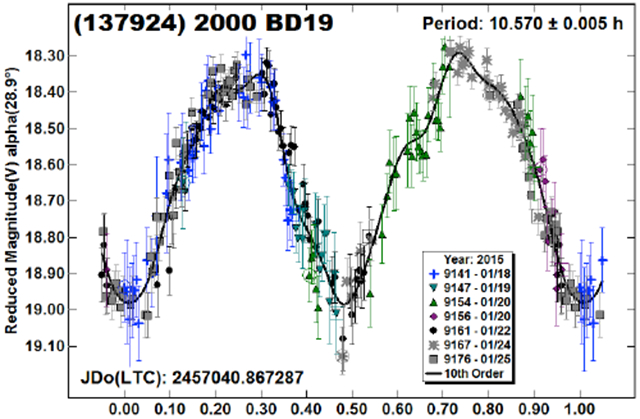
(137925) 2000 BJ19.
The period spectrum for 2000 BJ 19 shows two solutions, both nearly commensurate with an Earth day. The longer period, 48 ± 2 h, is adopted for this paper, although the shorter period of about 24 hours cannot be excluded, nor can one of about 12 hours. The moon and weather intervened in early March. By then, the asteroid had moved too far north for the telescopes at CS3.


(159454) 2000 DJ8.
The exact nature of 2000 DJ8 is a mystery. The lightcurve is similar to other objects, e.g., (69230) Hermes, which are thought to be two very close objects (sometimes misnamed contact binaries) that are fully synchronized, i.e., their rotation and orbital periods are the same. If true in this case, the smaller body is about half the effective size of the larger. The problem for 2008 DJ is that the two events are not evenly spaced and so imply an eccentric orbit. This is not likely given the orbital period (Alan Harris, private communications).

Harris suggested an alternative solution of the half-period, i.e., about 7 hours, and some large feature not viewed equatorially. This idea cannot be formally excluded. The next reasonable chance to observe this NEA is not until 2020 January-February (V ~ 17.2, Dec −4°).
(410088) 2007 EJ.
There were no previous entries in the LCDB for 2007 EJ. The next good opportunity for 2007 EJ is 2018 November (V ~ 16.9, Dec −49°).

(416071) 2002 NV.
Given the unusual shape of the lightcurve, this solution should not be considered too reliable, although it is probably correct to within about 1-2 hours and so is good enough for use in rotational statistics studies.

(416151) 2002 RQ25.
The period spectrum for 2002 RQ25 shows a number of possibilities, the two most likely being a monomodal solution at about 6 hours and a bimodal solution at 12 hours.



Usually, an amplitude of 0.42 mag dictates a bimodal lightcurve (Harris et al., 2014). However this is mitigated by the large phase angle where, due to deep shadowing effects, even a nearly spheroidal body can have a large amplitude. The longer period is adopted for this paper, but the shorter period cannot be formally excluded.
(427684) 2004 DH2.
There were no previous entries in the LCDB for 2004 DH2. The rounded minimums are somewhat unusual. Most elongated bodies show sharper minimums than maximums.

(429584) 2011 EU29.
The large amplitude and relatively low phase angle favor a bimodal solution (Harris et al., 2014). However, the large gaps in the coverage make for an uncertain period. The tumbling damping time (Pravec et al., 2005; 2014) is longer than the age of the Solar System, so signs of tumbling, e.g., the slopes of individual sessions not matching the model lightcurve, would not be unexpected. No such signs are obvious in this data set.
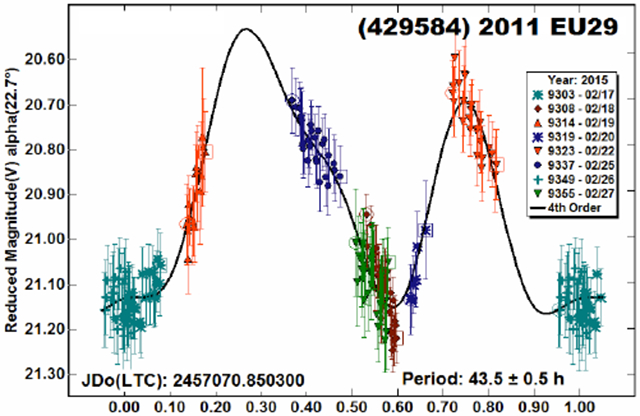
2002 EX8.
The period spectrum may have a strong preference for the period of 5.45 h, but the amplitude of the lightcurve barely exceeds the error bars, meaning that the variation is likely real but the period solution is suspect. In this lightcurve, the two maximums, at 0.3 and 0.8 rotation phase, are significantly different, which might prompt a search for a period twice long, i.e., that this is a monomodal solution. A search along those lines produced very unsatisfactory results with the slopes of the data unable to follow the resulting Fourier model curve.

2007 ED125.
This appears to be the first period reported in the literature for this NEA. The large amplitude and relatively short period make the solution secure.
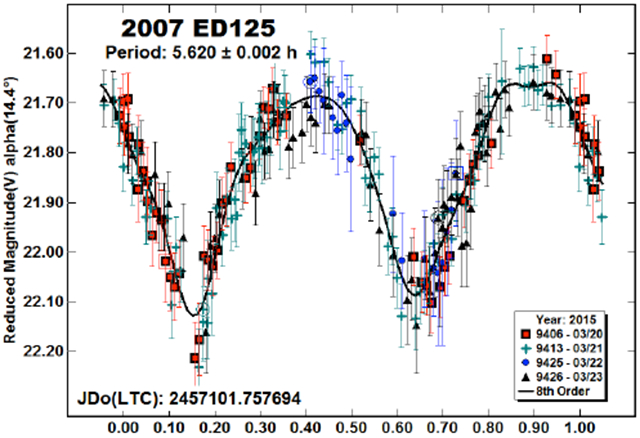
2011 WK15, 2013 BK18..
There were no previous entries in the LCDB for 2011 WK15 or 2013 BK18. Both periods are considered secure.


2014 QK434.
This NEA is similar to 2011 EU29 in that the period and size make it a good candidate for being in non-principal axis rotation (NPAR, tumbling) but there are no overt signs of that being the case. 2014 QK434 won’t be brighter than V = 18 again until 2033 September. Follow-up is left to the next generation of observers.

2014 UF206.
From 1995 through 2050, the 2015 apparition is the only one at which the asteroid is brighter than V = 20, so it was a unique opportunity for photometry observations. The lightcurves are for 2015 Jan 15, Jan 16, and the combined data set. The result from the combined set is considered secure.



2014 YM9.
Despite three nights of observations, the data set showed no discernable trend and only small variations over each night. The lightcurve shows the best fit, but unreliable, solution.

2014 YV34.
Since the error bars are about equal to the lightcurve amplitude, the result of 4.35 h is not very reliable. There were no previous entries in the LCDB. The 2015 apparition is the only one from 1995-2050 when the asteroid reaches V < 20.

2015 BK.
No solution could be found for 2015 BK, as shown by the flat line of the period spectrum. The lightcurve shows the raw data for one night. This appears to be the first reported attempt to determine the period for 2015 BK and probably the last for many years. The next time the asteroid is V < 20 is not until 2047.


2015 EZ.
The period spectrum shows several possible solutions for 2015 EZ. The lightcurves show the data phased to the two more likely periods. For this paper, the period of 6.57 h is adopted because of its more symmetrical shape. The next good opportunity (V < 19) to observe this NEA comes in 2023 April.



2015 AZ43.
This was another “one-shot” chance to determine the rotation period of an NEA. 2015 AZ43 won’t be brighter than 23.9 again through 2050. It peaked at V ~ 17.2 in 2015 mid-February but was within reach of the CS3 telescopes for only two days because of its sky position and rapid fading.
The raw plot for each night showed immediate indications that the asteroid was a super-fast rotator, i.e., P < 1 h. When working asteroids with estimated diameters of about D < 200 meters, the possibility of such short periods must be kept in mind. Most important, the exposures are not so long as to cover more than about 20% of the rotation period. In this case, the exposures were only 20 seconds, well under the limit of 6.7 minutes for a period of 36 min (see the discussion in Pravec et al., 2000).
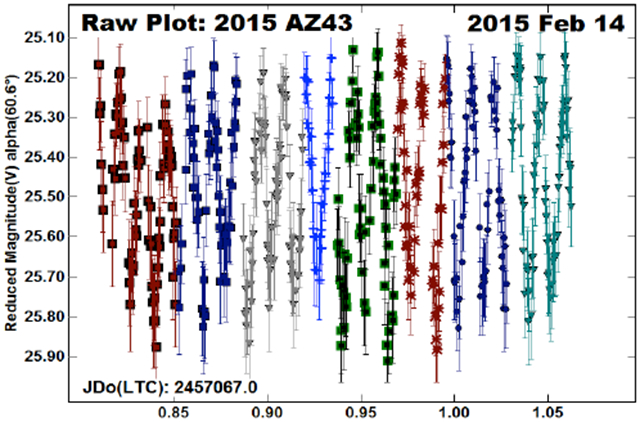

2015 BW92.
2015 BW92 has an estimated size of 500 meters, assuming an albedo of pv = 0.2. Its size and measured period make it another good candidate for tumbling but there were no signs of that being the case. The asteroid has similar viewing circumstances every 17 years. The next good opportunity is in 2032 February.

2015 CX12.
The period spectrum shows several strong solutions, each commensurate with an Earth day. That makes it difficult for a single station to find a reliable period. The monomodal solution at 6.1 h leads to the bimodal solution of 12.20 h, but with a large gap. The solution for 8.14 h would require a very large amplitude to complete the curve smoothly. The shorter solution at 6.1 h doesn’t make that likely. Given this and phase angle, a period of 12.20 h is adopted for this paper.




2015 DN215.
A period of 18.2 h is adopted for this paper, but a solution 36.3 h cannot be formally excluded. In fact, a number of other solutions is possible and so neither of these results is more likely than any other. The next, and last time through 2050, that this asteroid is V < 20 is in 2024 March.

2015 BO510.
The period spectrum for 2015 BO510 shows several strong possible solutions. Within the groups are the favored solution and then “sideband” periods that differ by one-half or one rotation over 24 hours.


A monomodal solution was rejected because it would have a period of about 1.5 h. Given the estimated size of 340 meters, this would be highly unlikely. The bimodal solution at 3.06 h seemed most likely (and is adopted for this paper). A check was also made for the double period at 6.12 hours (a trimodal solution at about 4.5 hours being rejected). A quadramodal lightcurve is not impossible at high phase angles, even with an amplitude of nearly 0.3 mag.
Despite the quadramodal lightcurve not showing a high degree of symmetry, a clue that the half-period might be valid, it was rejected because of gaps in coverage. The Fourier analysis algorithm in MPO Canopus can find a “best” solution, one with the lowest RMS fit, by also minimizing the number of overlapping data points in the phased lightcurve. This is called a fit by exclusion, and can lead to accepting an incorrect solution that is longer than the correct period.
The next good photometry opportunity for this NEA is in 2031 March and again 16 years later in 2047 March.
Table II.
Observing circumstances.
| Number | Name | 2015 mm/dd | Pts | Phase | LPAB | BPAB | Period | P.E. | Amp | A.E. | Grp |
|---|---|---|---|---|---|---|---|---|---|---|---|
| 1627 | Ivar | 01/02–01/07 | 350 | 17.7, 16.3 | 145 | 0 | 4.795 | 0.002 | 0. 27 | 0.03 | NEA |
| 1864 | Daedalus | 03/10–03/14 | 280 | 5.3, 5.0, 5.1 | 172 | 8 | 8.575 | 0.002 | 0.95 | 0.03 | NEA |
| 4401 | Aditi | 02/27–03/05 | 203 | 36.1, 33.0 | 156 | 36 | 6.670 | 0.005 | 0.29 | 0.03 | NEA |
| 5131 | 1990 BG | 01/18–02/04 | 153 | 21.8, 25.5 | 75 | −20 | 37.2 | 0.5 | 0.33 | 0.05 | NEA |
| 11066 | Sigurd | 02/02–02/04 | 174 | 27.4, 26.2 | 169 | 15 | 8.51 | 0.01 | 0.97 | 0.03 | NEA |
| 22099 | 2000 EX106 | 02/17–02/19 | 165 | 20.0, 18.4 | 166 | 7 | 6.31 | 0.02 | 0.41 | 0.03 | NEA |
| 22771 | 1999 CU3 | 02/22–03/12 | 229 | 18.5, 7.6 | 174 | −4 | 3.780 | 0.001 | 0.12 | 0.02 | NEA |
| 39796 | 1997 TD | 05/29–11/13 | 284 | 48.6, 17.8 | 280 | 11 | 223 | 5 | 0.92 | 0.05 | NEA |
| 85990 | 1999 JV6 | 01/16–01/18 | 360 | 27.7, 21.5 | 131 | −3 | 6.543 | 0.002 | 0.93 | 0.03 | NEA |
| 86067 | 1999 RM28 | 01/20–02/04 | 218 | 38.0, 32.2 | 171 | 16 | 9.196 | 0.005 | 0. 51 | 0.03 | NEA |
| 90416 | 2003 YK118 | 01/15–01/25 | 651 | 15.9, 23.7 | 112 | 12 | 43.58A | 0.05 | 0.13 | 0.01 | NEA |
| 99248 | 2001 KY66 | 01/17–01/25 | 260 | 8.6, 13.4 | 104 | −1 | 19.7 | 0.5 | 0.3 | 0.04 | NEA |
| 137924 | 2000 BD19 | 01/18–01/25 | 251 | 28.9, 25.4 | 141 | 20 | 10.570 | 0.005 | 0.69 | 0.04 | NEA |
| 137925 | 2000 BJ19 | 02/11–02/16 | 271 | 23.2, 23.0 | 161 | 22 | 48A | 2 | 0.17 | 0.02 | NEA |
| 159454 | 2000 DJ8 | 02/15–02/22 | 515 | 10.2, 19.1 | 138 | 7 | 14.244 | 0.007 | 0.25 | 0.03 | NEA |
| 410088 | 2007 EJ | 01/16–01/19 | 170 | 69.8, 64.6 | 81 | 25 | 4.781 | 0.006 | 0.16 | 0.02 | NEA |
| 416071 | 2002 NV | 01/20–01/25 | 161 | 16.7, 16.4 | 134 | −11 | 17.7 | 0.3 | 0.41 | 0.05 | NEA |
| 416151 | 2002 RQ25 | 02/11–02/15 | 1067 | 55.8, 71.4 | 153 | 34 | 12.191A | 0.005 | 0.72 | 0.05 | NEA |
| 427684 | 2004 DH2 | 02/19–02/26 | 206 | 23.0, 3.9 | 162 | −3 | 8.962 | 0.006 | 0.3 | 0.03 | NEA |
| 429584 | 2011 EU29 | 02/17–02/27 | 178 | 22.9, 7.2 | 164 | −3 | 43.5 | 0.5 | 0.65 | 0.1 | NEA |
| 2002 EX8 | 03/15–03/21 | 228 | 26.8, 35.4 | 160 | −8 | 5.45 | 0.03 | 0.27 | 0.05 | NEA | |
| 2007 ED125 | 03/20–03/23 | 216 | 14.4, 10.1 | 188 | 3 | 5.620 | 0.002 | 0.55 | 0.05 | NEA | |
| 2011 WK15 | 01/15–01/16 | 204 | 12.3, 12.5 | 122 | 5 | 3.541 | 0.005 | 0.21 | 0.02 | NEA | |
| 2013 BK18 | 02/08–02/10 | 330 | 55.3, 63.2 | 107 | −8 | 4.690 | 0.005 | 0.34 | 0.03 | NEA | |
| 2014 YM9 | 02/08–02/10 | 494 | 16.3, 20.9 | 130 | 5 | 7.3 | 0.1 | 0.04 | 0.01 | NEA | |
| 2014 YV34 | 01/14–01/17 | 196 | 17.6, 15.4 | 128 | 2 | 4.35 | 0.02 | 0.09 | 0.02 | NEA | |
| 2014 UF206 | 01/15–01/16 | 1000 | 10.7,13.9 | 119 | 7 | 6.831 | 0.004 | 0.20 | 0.02 | NEA | |
| 2014 QK434 | 01/02–01/15 | 640 | 66.3,46.8 | 73 | −13 | 78.4 | 0.2 | 0.60 | 0.05 | NEA | |
| 2015 BK | 02/14–02/15 | 334 | 23.1, 23.4 | 158 | 9 | - | - | - | - | NEA | |
| 2015 EZ | 03/15–03/23 | 151 | 22.4, 29.8 | 163 | −9 | 6.57 | 0.02 | 0.16 | 0.03 | NEA | |
| 2015 CX12 | 02/16–02/18 | 192 | 22.7, 20.8 | 145 | −15 | 12.2 | 0.02 | 0.67 | 0.03 | NEA | |
| 2015 AZ4 3 | 02/14–02/15 | 767 | 60.5, 65.1 | 163 | 28 | 0.59992 | 0.00004 | 0.58 | 0.05 | NEA | |
| 2015 BW92 | 02/08–02/26 | 716 | 7.5, 7.2, 21.2 | 137 | −1 | 26.80 | 0.05 | 0.75 | 0.03 | NEA | |
| 2015 DN215 | 03/10–03/15 | 431 | 18.5,8.6 | 179 | 5 | 18.2 | 0.5 | 0.06 | 0.01 | NEA | |
| 2015 BO510 | 03/13–03/15 | 241 | 59.7,65.2 | 199 | 29 | 3.06 | 0.03 | 0.28 | 0.03 | NEA |
preferred period for an ambiguous solution. Pts is the number of data points used in the analysis. The phase angle (α) is given at the start and end of each date range, unless it reached a minimum, which is then the second of three values. If a single value is given, the phase angle did not change significantly and the average value is given. LPAB and BPAB are, respectively the average phase angle bisector longitude and latitude, unless two values are given (first/last date in range). Grp is the orbital group of the asteroid. See Warner et al. (LCDB; 2009).
Acknowledgements
Funding for PDS observations, analysis, and publication was provided by NASA grant NNX13AP56G. Work on the asteroid lightcurve database (LCDB) was also funded in part by National Science Foundation Grant AST-1210099. This research was made possible through the use of the AAVSO Photometric All-Sky Survey (APASS), funded by the Robert Martin Ayers Sciences Fund.
References
- Bus SJ, Binzel RP (2002a). “Phase II of the Small Main-Belt Asteroid Spectroscopic Survey. The Observations.” Icarus 158, 106–145. [Google Scholar]
- Bus SJ, Binzel RP (2002b). “Phase II of the Small Main-Belt Asteroid Spectroscopic Survey. A Feature-Based Taxonomy.” Icarus 158, 146–177. [Google Scholar]
- Durech J (2002). “Shape Determination of the Asteroid (6053) 1993 BW3.” Icarus 159, 192–196. [Google Scholar]
- Gehrels T, Roemer E, Marsden BG (1971). “Minor Planets and Related Objects. VIL Asteroid 1971 FA.” Astron. J 76, 607–608. [Google Scholar]
- Harris AW, Young JW, Bowell E, Martin LJ, Millis RL, Poutanen M, Scaltriti F, Zappala V, Schober HJ, Debehogne H, Zeigler KW (1989). “Photoelectric Observations of Asteroids 3, 24, 60, 261, and 863.” Icarus 77, 171–186. [Google Scholar]
- Harris AW, Pravec P, Galad A, Skiff BA, Warner BD, Vilagi J, Gajdos S, Carbognani A, Hornoch K, Kusnirak P, Cooney WR, Gross J, Terrell D, Higgins D, Bowell E, Koehn BW (2014). “On the maximum amplitude of harmonics on an asteroid lightcurve.” Icarus 235, 55–59. [Google Scholar]
- Harris AW, Young JW, Scaltriti F, Zappala V (1984). “Lightcurves and phase relations of the asteroids 82 Alkmene and 444 Gyptis.” Icarus 57, 251–258. [Google Scholar]
- Henden AA, Terrell D, Levine SE, Templeton M, Smith TC, Welch DL (2009). http://www.aavso.org/apass
- Kaasalainen M, Torppa J, Piironen J (2002). “Models of Twenty Asteroids from Photometric Data.” Icarus 159, 369–395. [Google Scholar]
- Kaasalainen M, Pravec P, Krugly YN, Sarounová L, Torppa J, Virtanen J, Kaasalainen S, Erikson A, Nathues A, Durech J, Wolf M, Lagerros JSV, Lindgren M, Lagerkvist C-I, Koff R, Davies J, Mann R, Kusnirák P, Gaftonyuk NM, Shevchenko VG, Chiorny VG, Belskaya IN (2004). “Photometry and models of eight near-Earth asteroids.” Icarus 167, 178–196. [Google Scholar]
- Kaasalainen M Durech J. Warner BD, Krugly YN., Gaftonyuk NM (2007). “Acceleration of the rotation of asteroid 1862 Apollo by radiation torques.” Nature 446, 420–422. [DOI] [PubMed] [Google Scholar]
- Krugly Yu.N., Belskaya IN, Shevchenko VG, Chiorny VG, Velichko FP, Mottola S, Erikson A, Hahn G, Nathues A, Neukum G, Gaftonyuk NM, Dotto E. (2002). “The Near-Earth Objects Follow-up Program. IV. CCD Photometry in 1996-1999.” Icarus 158, 294–304. [Google Scholar]
- Pravec P, Wolf M, Varady M, Barta P (1995). “CCD Photometry of 6 Near-Earth Asteroids.” Earth, Moon, and Planets 71, 177–187. [Google Scholar]
- Pravec P, Wolf M, Sarounova L, Harris AW, Davies JK (1997). “Spin Vector, Shape, and Size of the Amor Asteroid (6053) 1993 BW3.” Icarus 127, 441–451. [Google Scholar]
- Pravec P, Wolf M, Sarounova L (1998). “Lightcurves of 26 Near-Earth Asteroids.” Icarus 136, 124–153. [Google Scholar]
- Pravec P, Hergenrother C, Whiteley R, Sarounova L, Kusnirak P (2000). “Fast Rotating Asteroids 1999 TY2, 1999 SF10, and 1998 WB2.” Icarus 147, 477–486. [Google Scholar]
- Pravec P, Wolf M, Sarounova L (2002, 2003). http://www.asu.cas.cz/~ppravec/neo.htm
- Pravec P, Harris AW, Scheirich P, Kušnirák P, Šarounová L, Hergenrother CW, Mottola S, Hicks MD, Masi G, Krugly, Yu N, Shevchenko VG, Nolan MC, Howell ES, Kaasalainen M, Galád A, Brown P, Degraff DR, Lambert JV, Cooney WR, Foglia S. (2005). “Tumbling asteroids.” Icarus 173, 108–131. [Google Scholar]
- Pravec P, Scheirich P, Durech J, Pollock J, Kusnirak P, Hornoch K, Galad A, Vokrouhlicky D, Harris AW, Jehin E, Manfroid J, Opitom C, Gillon M, Colas F, Oey J, Vrastil J, Reichart D, Ivarsen K, Haislip J, LaCluyze A (2014). “The tumbling state of (99942) Apophis.” Icarus 233, 48–60. [Google Scholar]
- Thomas CA, Emery JP, Trilling DE, Delbó M, Hora JL, Mueller M. (2014). “Physical characterization of Warm Spitzer-observed near-Earth objects.” Icarus 228, 217–246. [Google Scholar]
- Warner BD (2007). “Initial Results of a Dedicated H-G Program.” Minor Planet Bul. 34, 113–119. [Google Scholar]
- Warner BD, Harris AW, Pravec P (2009). “The Asteroid Lightcurve Database.” Icarus 202, 134–146. [Google Scholar]
- Warner BD (2014a). “Near-Earth Asteroid Lightcurve Analysis at CS3-Palmer Divide Station: 2013 June-September.” Minor Planet Bul. 41, 41–47. [PMC free article] [PubMed] [Google Scholar]
- Warner BD (2014b). “Near-Earth Asteroid Lightcurve Analysis at CS3-Palmer Divide Station: 2014 January-March.” Minor Planet Bul. 41, 157–168. [PMC free article] [PubMed] [Google Scholar]
- Warner BD (2015). “Near-Earth Asteroid Lightcurve Analysis at CS3-Palmer Divide Station: 2014 June-October.” Minor Planet Bul. 42, 41–53. [PMC free article] [PubMed] [Google Scholar]


